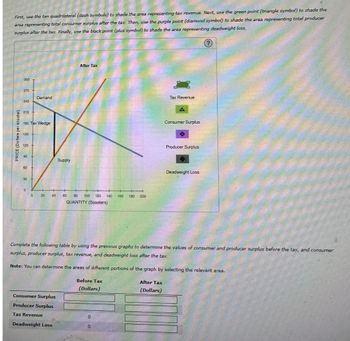
ENGR.ECONOMIC ANALYSIS
14th Edition
ISBN: 9780190931919
Author: NEWNAN
Publisher: Oxford University Press
expand_more
expand_more
format_list_bulleted
Question

Transcribed Image Text:First, use the tan quadrilateral (dash symbols) to shade the area representing tax revenue. Next, use the green point (triangle symbol) to shade the
area representing total consumer surplus after the tax. Then, use the purple point (diamond symbol) to shade the area representing total producer
surplus after the tax. Finally, use the black point (plus symbol) to shade the area representing deadweight loss.
PRICE (Dollars per scooter)
300
270
240
210
180 Tax Wedge
150
120
90
60
Demand
CA
0 20
40
Consumer Surplus
Producer Surplus
Tax Revenue
Supply
Deadweight Loss
After Tax
60
80 100 120 140 160 180 200
QUANTITY (Scooters)
Before Tax
(Dollars)
Complete the following table by using the previous graphs to determine the values of consumer and producer surplus before the tax, and consumer
surplus, producer surplus, tax revenue, and deadweight loss after the tax.
Note: You can determine the areas of different portions of the graph by selecting the relevant area.
0
0
Tax Revenue
After Tax
(Dollars)
Consumer Surplus
Producer Surplus
Deadweight Loss
(?
Expert Solution
This question has been solved!
Explore an expertly crafted, step-by-step solution for a thorough understanding of key concepts.
This is a popular solution
Trending nowThis is a popular solution!
Step by stepSolved in 5 steps with 2 images

Knowledge Booster
Learn more about
Need a deep-dive on the concept behind this application? Look no further. Learn more about this topic, economics and related others by exploring similar questions and additional content below.Similar questions
- Nonearrow_forwardSuppose Home is a small exporter of wheat. At the world price of 100 US dollars per tonne, Home growers export 20 tons of wheat. Now suppose the Home government decides to support its domestic producers with an specific export subsidy of 40 US dollars per tonne. Use Figure 1 to answer the following questions: Figure 1: Supply and Demand for Wheat at Home Home price 140 100 X 10 20 40 50 Supply Demand Quantity (a) Explain why consumer and producer surplus can be used to gauge the change in welfare caused by the export subsidy on individuals and firms.arrow_forwardIn Figure 1, suppose the marginal value for gasoline falls by $6 for every quantity demanded for all gas stations in the market. Next, assume that the government enacts a price ceiling of $2. What is the loss in consumer surplus? A) $6B) $2C) $12D) There is no consumer welfare loss because prices are lower.E) There is not enough information to calculate.arrow_forward
- First, use the black point (plus symbol) to indicate the equilibrium price and quantity of designer handbags in the absence of a tax. Then use the green point (triangle symbol) to shade the area representing total consumer surplus (CS) at the equilibrium price. Next, use the purple point (diamond symbol) to shade the area representing total producer surplus (PS) at the equilibrium price. PRICE (Dollars per handbag) 500 450 400 Demand 350 300 250 200 Before Tax Supply 150 100 50 0 0 160 320 480 640 800 960 1120 1280 1440 1600 QUANTITY (Handbags) + Equilibrium Consumer Surplus Producer Surplus ?arrow_forwardSuppose an additional "special" tax of $0.10 per litre is imposed on the sale of gasoline in one province. Prior to the tax the price was $1.30 per litre and 10 million litres of gasoline are sold per day. After imposition of the tax, the new equilibrium price and quantity are $1.38 per litre and 9.6 million litres per day. What is the direct burden of this "special" tax?arrow_forwardNote:- Do not provide handwritten solution. Maintain accuracy and quality in your answer. Take care of plagiarism. Answer completely. You will get up vote for sure.arrow_forward
- help please answer in text form with proper workings and explanation for each and every part and steps with concept and introduction no AI no copy paste remember answer must be in proper format with all workingarrow_forwardSuppose the world price of oil is $15 per barrel. At that price, the United States imports 400 million barrels daily and consumes 600 million barrels daily. The government then imposes a $5 per barrel tax on oil imports. For every dollar increase in oil prices, domestic consumption decreases by 20 million barrels per day, while domestic production increases by 40 million barrels per day. 3. What will be the cost of inefficient production, loss in consumer surplus, and deadweight loss? Use a diagram to help answer the question.arrow_forward
arrow_back_ios
arrow_forward_ios
Recommended textbooks for you

 Principles of Economics (12th Edition)EconomicsISBN:9780134078779Author:Karl E. Case, Ray C. Fair, Sharon E. OsterPublisher:PEARSON
Principles of Economics (12th Edition)EconomicsISBN:9780134078779Author:Karl E. Case, Ray C. Fair, Sharon E. OsterPublisher:PEARSON Engineering Economy (17th Edition)EconomicsISBN:9780134870069Author:William G. Sullivan, Elin M. Wicks, C. Patrick KoellingPublisher:PEARSON
Engineering Economy (17th Edition)EconomicsISBN:9780134870069Author:William G. Sullivan, Elin M. Wicks, C. Patrick KoellingPublisher:PEARSON Principles of Economics (MindTap Course List)EconomicsISBN:9781305585126Author:N. Gregory MankiwPublisher:Cengage Learning
Principles of Economics (MindTap Course List)EconomicsISBN:9781305585126Author:N. Gregory MankiwPublisher:Cengage Learning Managerial Economics: A Problem Solving ApproachEconomicsISBN:9781337106665Author:Luke M. Froeb, Brian T. McCann, Michael R. Ward, Mike ShorPublisher:Cengage Learning
Managerial Economics: A Problem Solving ApproachEconomicsISBN:9781337106665Author:Luke M. Froeb, Brian T. McCann, Michael R. Ward, Mike ShorPublisher:Cengage Learning Managerial Economics & Business Strategy (Mcgraw-...EconomicsISBN:9781259290619Author:Michael Baye, Jeff PrincePublisher:McGraw-Hill Education
Managerial Economics & Business Strategy (Mcgraw-...EconomicsISBN:9781259290619Author:Michael Baye, Jeff PrincePublisher:McGraw-Hill Education


Principles of Economics (12th Edition)
Economics
ISBN:9780134078779
Author:Karl E. Case, Ray C. Fair, Sharon E. Oster
Publisher:PEARSON

Engineering Economy (17th Edition)
Economics
ISBN:9780134870069
Author:William G. Sullivan, Elin M. Wicks, C. Patrick Koelling
Publisher:PEARSON

Principles of Economics (MindTap Course List)
Economics
ISBN:9781305585126
Author:N. Gregory Mankiw
Publisher:Cengage Learning

Managerial Economics: A Problem Solving Approach
Economics
ISBN:9781337106665
Author:Luke M. Froeb, Brian T. McCann, Michael R. Ward, Mike Shor
Publisher:Cengage Learning

Managerial Economics & Business Strategy (Mcgraw-...
Economics
ISBN:9781259290619
Author:Michael Baye, Jeff Prince
Publisher:McGraw-Hill Education